Foreword:
I am regularly dubbed as the overbiker. My “road” bike tips the scales at 26lbs, has carbon enduro rims, a 180mm dropper post and 2.25” tires. I generally have a tendency to turn what is normally a rather sporty bike, into a chunkier, dirt-focused ride. It usually happens after a big mechanical failure or crash where I convince myself that bigger tires or beefier parts would’ve prevented the issue. Sometimes this is true, and others I end up shooting myself in the foot. Extra weight and chunky tires tend to add a lot of resistance, increasing effort. I am good at tuning that out for the most part, but then I get invited on rides with the race crew. When it comes to keeping up with my friends on their fast bikes, it can sometimes become a bit of an issue.
Your North American Editor, Anne-Marije Rook, is among those regularly giving me flak for overbiking, arguing that I’d be so much faster (editor’s note: even faster!) if I simply rode a zippier bike. We finally had the opportunity to put that to test with this Salsa Warbird C Force AXS Wide review bike. I don’t race gravel but I admittedly was pretty excited to give this thing a go.
2024 Salsa Warbird C Force AXS Wide: at a glance
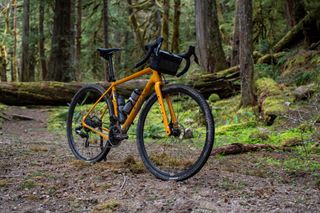
(Image credit: Charlie Kohlmeier)
- Frame: Warbird Carbon
- Fork: Waxwing Deluxe V2
- Color: Mustard Yellow
- Groupset: SRAM Force AXS
- Gearing: 2×12 consisting of a 10-36t cassette and 43/30 crankset
- Brakes: SRAM Force AXS HRD with 160mm SRAM Paceline rotors
- Headset: FSA NO.42/ACB
- Stem: Salsa Guide
- Handlebar: Salsa Cowbell Carbon
- Bar Tape: Velo anti-slip, shock-proof silicone tape
- Seatpost: Salsa Guide Carbon
- Saddle: WTB SL8 Medium Cromoly SL
- Front Wheel: DT Swiss 370 12 x 100mm hub, WTB CZR i23 700c carbon rim, 24h
- Rear Wheel: DT Swiss 370 Ratchet LN 12 x 142mm hub, WTB CZR i23 700c carbon rim, 24h
- Tyres: Teravail Cannonball 700c x 42mm, Durable casing, tubeless-ready
- Price: $6,999 USD
Initial impressions:
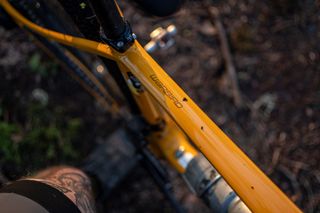
(Image credit: Charlie Kohlmeier)
When I picked up the new Salsa Warbird from my local bike shop, the first thing I noticed was how sharp it looks. The Mustard Yellow is a great hue, and would go really well with any bit of kit. The Warbird is light — to me. My 54.5cm test rig tipped the scales at 18.7lbs without pedals and cages. Still, the bike is clad with all the possible mounts you could want, cable routing is no-nonsense, there’s routing for a dynamo hub and a dropper post, and it comes with durable casing cannonballs. As another reviewer write last year, it truly is “a race bike for the people”.
No surprise really as the Salsa Warbird is the OG gravel bike. Since gravel was created as a category, the Warbird has been there, offering adventurers a bike capable of quickly and comfortably covering a multitude of surfaces. In that same timeframe, we have seen gravel bikes trend more toward their shreddier, off-road brethren. Dropper posts, suspension and bigger tires have become more of a commonplace. It isn’t uncommon for people to look at a gravel bike and make some sort of snarky “just ride a mountain bike” comment. Now I don’t wanna make this review into a discussion about “what is gravel”, but I would like to use that to point out that gravel in 2024 is such a broad category that it is near impossible to create a bike that checks all the boxes.
For someone who’s more on the mountain bike side of things, and this Warbird (with a few options) would check the majority of boxes that I would come to expect from a “gravel” bike. At the same time, I suspect that this platform would also check a majority of boxes for someone more road-oriented and those looking for a race bike.
Over the course of 30 days, I set out to test the Warbird on a handful of different styles of rides to see where the platform excelled, where (if?) it was lacking and whether it allowed this overbiker to keep up with my fast friends.
Construction & Geo
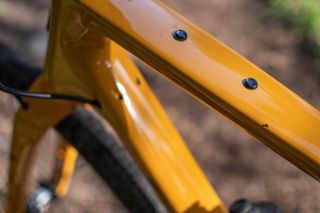
(Image credit: Charlie Kohlmeier)
This is Salsa’s fourth evolution of the Warbird, and with it comes some geometry tweaks, the biggest update being longer top tubes. This allows for a similarly long wheelbase while shrinking the stem and cockpit to give the bike snappier handling while maintaining the overall stability.
I am testing the 54.5cm, which is a new size as the previous v3 Warbird came in a 55cm. Here’s how the latest two generations compare in geometry:
| Header Cell – Column 0 | Old (55cm) | New (55cm) |
|---|---|---|
| Reach | 377 | 371.97 |
| Stack | 567 | 565.97 |
| Seat tube | 520 | 475 |
| Headtube Angle | 70.5 | 70.75 |
| Seat Tube Angle | 73º | 73º |
| BB Drop | 70 | 70 |
| Chainstay | 430 | 430 |
| Wheelbase | 1025 | 1022.39 |
| Fork Offset (Rake) | 45 | 50 |
On top of the updated geometry, Salsa has given the Warbird some extra utility:
- Class 5 Vibration Reduction System
- Dual wheel size capability — 700×45 or 650×2.1”
- Increased size range
- Updated frame layup with increased power transfer, more dampening, and lower standover
- The frame is fully kitted for bikepacking with bento mounts, fork mounts, downtube mounts, and up to three bottles inside the frame (56cm + above)
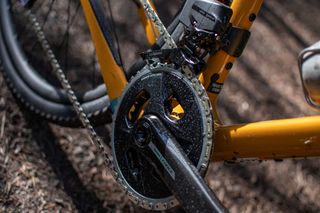
(Image credit: Charlie Kohlmeier)
The bike can be run with a single ring or double ring in the front. If you choose a mechanical front derailleur, it will occupy the routing for a dropper post. You can get 2x + dropper if you go with a wireless mech. All of the cables are internally sleeved, making cable routing a breeze. Like any good gravel bike, the Warbird has mounts for full-fenders, and is compatible with a rear rack when using their rack adapted seat collar.
The riding
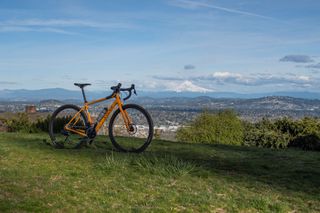
(Image credit: Charlie Kohlmeier)
I took the Warbird out on a handful of rides to see how it could handle a variety of situations. I didn’t compete in any races, so I can’t comment on its podium prowess. I can, however, tell you about how easy this bike is to live with, and where I see it truly shining. I live in the Pacific Northwest where our “gravel” rides can get a little carried away. A variety of surfaces, plenty of steep climbs, singletrack descents and all the shenanigans along the way.
First Ride — Around town
I headed out for a favorite hilly local loop that included crossing town and heading up into the hills. At first all I could pay attention to was how narrow the bars were for me, but after a few minutes I began to find familiarity. Out of the gate, the Warbird was noticeably smoother than what I remembered carbon frames to feel like. It rolled through the chatter of the broken city streets with ease. Shifting on the Force AXS is buttery smooth, and having all the extra gears was convenient on the streets. The bike loves to climb, and I felt noticeably less fatigued when giving it a hard effort up higher grades. On one particular dirt section that climbs just about 500’ (152 meters) in three quarters of a mile, I found myself tapping for the granny gear (38-46) that I am used to on my personal bike. The terrain was exceptionally mucky on this go, in the dry months of summer, the taller gearing would likely be fine. On the road descents, the bike likes to move. The longer wheelbase feels stable and comfortable when getting up to higher speeds on rough roads. On my first more technical descent, a firelane, I felt a bit like a fish out of water with the rigid seat post. On sections where I would normally just pull my front end over a rut and plow through, I felt much more hesitant. The bike definitely wanted more, but apparently my skills need reworking! It was a learning experience for me, and I enjoyed getting a little terrified on a descent that I, with the help of a dropper post, normally don’t think twice on.
Second Ride — Big Road Day
Two days later my friends invited me on a true road/light gravel epic that included some long stretches of tarmac and some beautiful, forested gravel sections. Making use of the Warbird’s many accessory mounts, I opted for two full-size bottles and my favorite Oneup pump in the triangle as well as a handlebar bag full of snacks.
I was extremely impressed with how comfortable the Warbird is on the road. It is fast, consistent and smooth. Something strange that I noticed was how planted it felt when riding without hands. I don’t know if that is a body position thing, or a wheelbase thing, but it has a whole different level of confidence without input from my hands. It’s also very clear how much more aerodynamic the narrow bars are compared to the much wider, dirt-specific offerings. I could feel that less effort was needed to keep pace with my friends.
The Warbird does well on long stretches of smooth gravel, too, but when things get really rough, the bike lets you know that you’ll want to tone it down. On the roughest of gravel, I would love to see what this bike is capable of with more tyre. Salsa states that max clearance on the Warbird is 650b x 50mm, so something like the Continental Terra, Goodyear Connector, Pirelli Cinturato or Donnelly X’Plor could really help soak up the bumps and liven up the ride and handling when the going gets rough.
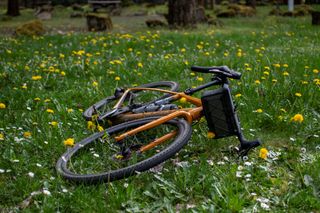
(Image credit: Charlie Kohlmeier)
Third Ride — 200k shenanigans
I let the Warbird sit for a week after our big road day. I wanted to spend some time on my other bikes again to re-centre myself and see if I still felt the same way about the novelty items like wider bars and a dropper posts. Then, I got an invite for a larger group ride to hit some little bits of singletrack. This is mostly the goal when I go for big rides, so I was very excited to get weird on the Warbird. The ride started as a mostly chill road ride, with a couple gravel stretches, then as we crossed into Mt. Hood National Forest we caught some special bits of singletrack that I would otherwise miss because they are simply too far out of the way to be a car- destination. The first stretch was descending the Old Salmon River trail. It is an old trail that parallels the river. Covered in roots, rocks, sand and the occasional bridge, it was a great skills and bike test. At this point, I was more used to the rigid seat post and how to maneuver the bike with it. I was feeling more confident bunnyhopping obstacles and charging a bit harder through rougher stuff. There’s definitely a limit, and it is usually any obstacle that is big enough to kick the seat up into your rear and send your weight forward. I am also used to descending in flared drops where you have loads of control and stability. On the Warbird I found the best descending to happen on the hoods, this could, of course, also be a SRAM vs Shimano lever dispute. On the Warbird, the drops feel a little too deep and low to really benefit descending through rough stuff. Where on the hoods you can keep your weight centered more easily and get the front end up and over obstacles.
Climbing technical bits is a completely different ballgame, but it is fun to try. Feels like slow and controlled is the move here. Our second ribbon of singletrack was the Still Creek trail, which starts with a punchy climb and ends with a long fast flowing descent. Fewer obstacles here, and that felt better aboard the Warbird. You could start to open it up, letting the bike soak up the little stuff and using the bigger roots as launch ramps. The bike is really fun with good sight lines and softer soil, but what bike isn’t.
Our final bit of singletrack for the day was a classic Sandy Ridge trail: Hide-n-seek. This trail is a machine-built flow trail full of berms, rollers, tabletops and more. This is where I really missed the dropper post. Of course, doing silly stuff like this on drop bars is always a great test of skill, and makes you glad that modern mountain bikes exist.
Fourth Ride — The Commute
A review wouldn’t feel complete without seeing how the bike handled my weekly commute. Lo and behold: I was 6 minutes faster to work on the Warbird.
Unfortunately on the way home I got a puncture. I went to put a plug in, but when I started to pump it up I noticed something was up. The bike had tubes! Not a problem or an issue, just figured that a high-end bike like this would come setup tubeless out of the gate. Luckily, I had a spare tube with me and was able to easily get back on the road.
Fifth Ride — Race pace climb-a-thon
For the next ride, I wanted to see how the bike would ride in a more road focused layout, so I threw on some Ultradynamico Cava tyres and headed out to join in on a Portland classic: The Ronde. It’s a route designed to hit all the very best and steepest road climbs in Portland. This was the first time I truly felt like I was on the right bike. The Warbird felt so much better with the faster, more efficient tires. It climbed better, and kept speed better on descents. The Warbird just wanted to move. I also noticed a drastic difference in feel, which I might chalk up to the fact that the Cavas were setup tubeless and I was running a few less PSI. The ride was long and strenuous. The Warbird was definitely a weapon that day. On all my previous rides, I felt like I was simply riding a bike to do a review. I never really felt connected to the bike, just a passenger. On The Ronde, I would’ve been much less happy on one of my personal bikes. The Warbird was the right tool for the job.
Overall Thoughts:
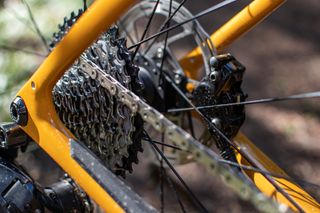
(Image credit: Charlie Kohlmeier)
At the end of the day, I was indeed faster aboard the Warbird than I am on my personal bikes. It was more efficient, and faster on long stretches of road than any of my daily rides. I do feel like I missed a bit of the fun along the way though. Those few and far between moments of dropping the saddle and charging through roots, or trying to hit a weird trail gap that is almost always a bad decision. Aboard the Warbird, I was less inspired to get weird, and more inspired to sit and spin.
The Warbird is a comfortable, and approachable bike. A true gravel bike. But I worry that in it’s original form, it might miss out on some of the fun that I know it wants to have along the way.
Value
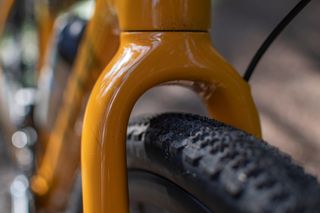
(Image credit: Charlie Kohlmeier)
The Salsa Warbird C Force AXS Wide comes with a price tag of $6,999 USD. While the parts spec is impressive, I think the return on your investment is pretty low compared to buying the frame and building up your own to suit your needs. Salsa cut corners on things like the lower-end hub and an in-house cockpit, albeit carbon. And when you can get the GRX 600 version for $3,399 USD, it’s hard to justify the extra three grand for the spec.
My recommendation? Buy the Warbird frameset for $2,199 and take the remaining $4,800 to build it up how you like.
Verdict
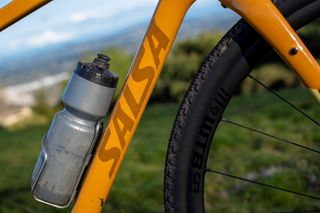
(Image credit: Charlie Kohlmeier)
The Salsa Warbird is an easy to live with, all-terrain machine. It is versatile, efficient and comfortable. That being said, I think the bike feels rather vanilla, which isn’t necessarily a bad thing, but at this price point, I think you’ll have a hard time convincing yourself of the value.
I believe Salsa created an honorable successor to the OG gravel munching machine. I simply can’t recommend this top spec build, but I would absolutely recommend the frame as a platform to build your own dream machine on.
If you are coming from the land of mountain biking and are interested in a gravel bike, the Warbird would be a great option that could fill the roles of road bike and gravel bike equally well. Likewise, if you are a roadie looking for something that can handle a bit more, the Warbird would be a solid bike to look into. It will have clearance for chunky rubber, a dropper, and still be light and quick.
Overall, the Warbird is a really solid bike that is a smart choice for almost everyone, but it’s missing that little extra bit of something special that would take it to a 5 in my book.

